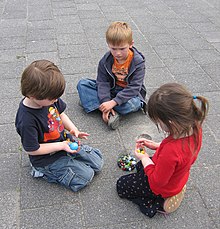
Back جماعة الرفاق Arabic Peergroup German Grupo de pares Spanish קבוצת השווים HE Kelompok sebaya ID Gruppo dei pari Italian ピアグループ Japanese ក្រុមមិត្តភក្តិ (Peer group) Cambodian 또래집단 Korean Peergroup (psychologie) Dutch

In sociology, a peer group is both a social group and a primary group of people who have similar interests (homophily), age, background, or social status. The members of this group are likely to influence the person's beliefs and behaviour.[1]
During adolescence, peer groups tend to face dramatic changes. Adolescents tend to spend more time with their peers and have less adult supervision. Peer groups give a sense of security and identity. A study found that during the adolescent phase as adolescents spend double time with their peers compared to the time youth spend with their parents.[2] Adolescents' communication shifts during this time as well. They prefer to talk about school and their careers with their parents, and they enjoy talking about sex and other interpersonal relationships with their peers.[3] Children look to join peer groups who accept them, even if the group is involved in negative activities. Children are less likely to accept those who are different from them.[3] Friendship and support is important for people to have an active social life. Similarly, it is equally important to people with disability as it can help them to feel included, valued and happier.[4] Social interaction among peers may influence development; quality of life outcomes. This interaction and positive relationship benefit subjective wellbeing and have a positive effect on mental and physical health.[5]
Cliques are small groups typically defined by common interests or by friendship. Cliques typically have 2–12 members and tend to be formed by age, gender, race, and social class. Clique members are usually the same in terms of academics and risk behaviors.[3] Cliques can serve as an agent of socialization and social control.[6] Being part of a clique can be advantageous since it may provide a sense of autonomy, a secure social environment, and overall well-being.
Crowds are larger, more vaguely defined groups that may not have a friendship base.[7] Crowds serve as peer groups, and they increase in importance during early adolescence, and decrease by late adolescence.[3] The level of involvement in adult institutions and peer culture describes crowds.
- ^ Peer group. (n.d.). Dictionary.com. Retrieved October 25, 2012, from http://dictionary.reference.com/browse/peer+group Archived 2015-09-25 at the Wayback Machine
- ^ Albert, D; Chein, J; Steinberg, L (2013). "Peer Influences on Adolescent Decision Making". Current Directions in Psychological Science. 22 (2): 114–120. doi:10.1177/0963721412471347. PMC 4276317. PMID 25544805.
- ^ a b c d Steinberg, Laurence (2010). Adolescence. New York: McGraw Hill. pp. 1–434. ISBN 978-0-07-353203-5.
- ^ Chadwick, D; Wesson, C; Fullwood, C (2013). "Internet access by people with intellectual disabilities: Inequalities and opportunities". Future Internet. 5 (3): 376–397. doi:10.3390/fi5030376. hdl:2436/622455.
- ^ Cohen, S (2004). "Social Relationships and Health". American Psychologist. 59 (8): 676–684. doi:10.1037/0003-066X.59.8.676. PMID 15554821.
- ^ Adler, Patricia A.; Adler, Peter (September 1995). "Dynamics of Inclusion and Exclusion in Preadolescent Cliques". Social Psychology Quarterly. 58 (3): 145–162. CiteSeerX 10.1.1.474.9716. doi:10.2307/2787039. JSTOR 2787039.
- ^ Brown, B. B. (1990). "Peer groups and peer cultures" (PDF). In Feldman, S. S.; Elliott, G. R. (eds.). At the threshold: The developing adolescent. Cambridge, MA, US: Harvard University Press. pp. 171–196.
© MMXXIII Rich X Search. We shall prevail. All rights reserved. Rich X Search